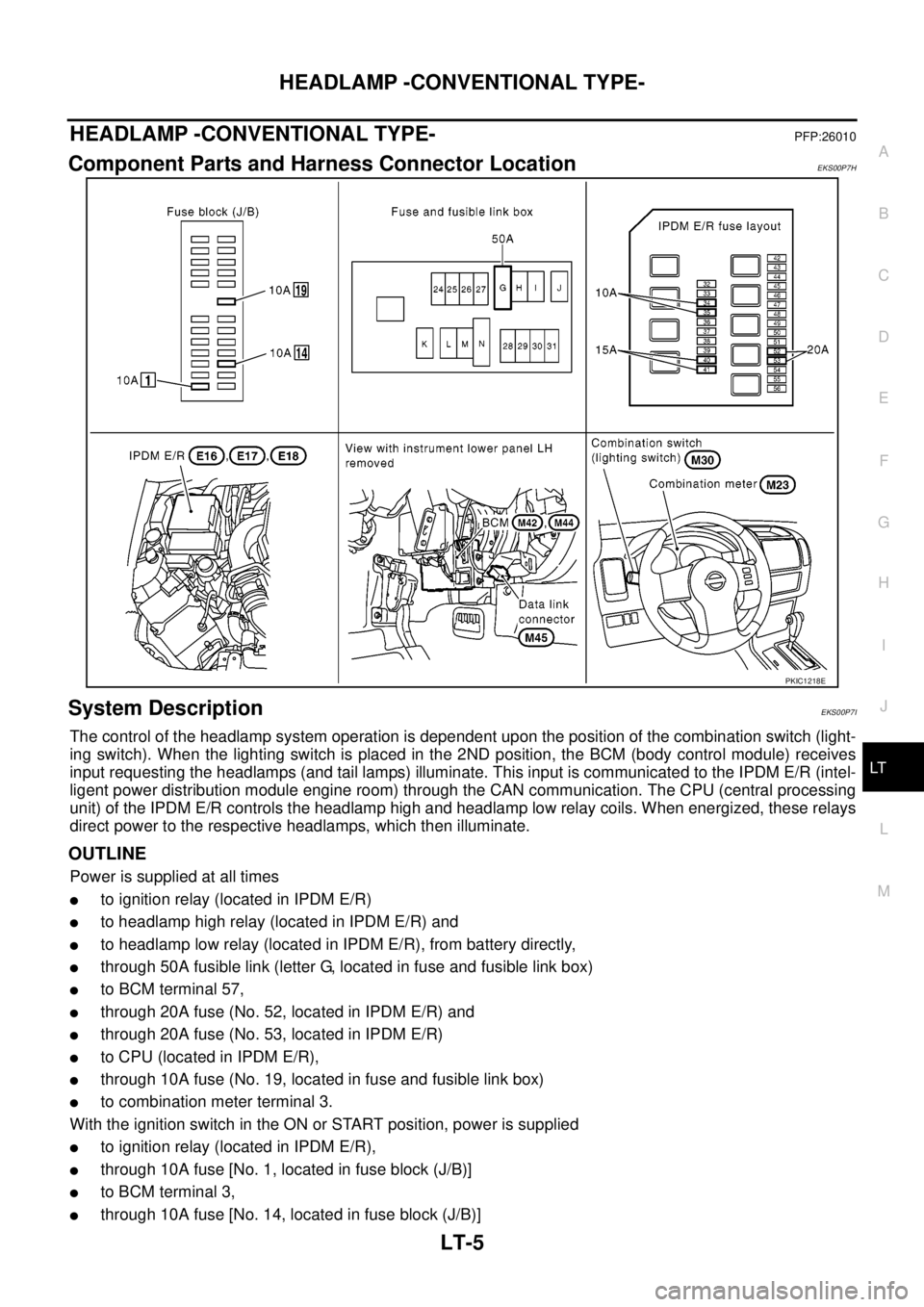2005 NISSAN NAVARA ignition
[x] Cancel search: ignitionPage 2078 of 3171
![NISSAN NAVARA 2005 Repair Workshop Manual TROUBLE DIAGNOSIS FOR SYSTEM
LAN-301
[CAN]
C
D
E
F
G
H
I
J
L
MA
B
LAN
BCM Circuit InspectionEKS00O54
1.CHECK CONNECTOR
1. Turn ignition switch OFF.
2. Disconnect the battery cable from the negative te NISSAN NAVARA 2005 Repair Workshop Manual TROUBLE DIAGNOSIS FOR SYSTEM
LAN-301
[CAN]
C
D
E
F
G
H
I
J
L
MA
B
LAN
BCM Circuit InspectionEKS00O54
1.CHECK CONNECTOR
1. Turn ignition switch OFF.
2. Disconnect the battery cable from the negative te](/manual-img/5/57362/w960_57362-2077.png)
TROUBLE DIAGNOSIS FOR SYSTEM
LAN-301
[CAN]
C
D
E
F
G
H
I
J
L
MA
B
LAN
BCM Circuit InspectionEKS00O54
1.CHECK CONNECTOR
1. Turn ignition switch OFF.
2. Disconnect the battery cable from the negative terminal.
3. Check terminals and connector of BCM for damage, bend and loose connection (control module side and
harness side).
OK or NG
OK >> GO TO 2.
NG >> Repair terminal or connector.
2.CHECK HARNESS FOR OPEN CIRCUIT
1. Disconnect BCM connector.
2. Check resistance between BCM harness connector terminals.
OK or NG
OK >> Replace BCM. Refer toBCS-17, "Removal and Installa-
tion of BCM".
NG >> Repair harness between BCM and data link connector.
Combination Meter Circuit InspectionEKS00O55
1.CHECK CONNECTOR
1. Turn ignition switch OFF.
2. Disconnect the battery cable from the negative terminal.
3. Check terminals and connector of combination meter for damage, bend and loose connection (meter side
and harness side).
OK or NG
OK >> GO TO 2.
NG >> Repair terminal or connector.
2.CHECK HARNESS FOR OPEN CIRCUIT
1. Disconnect combination meter connector.
2. Check resistance between combination meter harness connec-
tor M23 terminals 12 and 11.
OK or NG
OK >> Replace combination meter.
NG >> Repair harness between combination meter and data
link connector.
BCM connector TerminalResistance
(Approx.)
M42 22 21 54 – 66W
PKIC0213E
12 – 11 : Approx. 54 – 66W
PKIA6837E
Page 2079 of 3171
![NISSAN NAVARA 2005 Repair Workshop Manual LAN-302
[CAN]
TROUBLE DIAGNOSIS FOR SYSTEM
Transfer Control Unit Circuit Inspection
EKS00O56
1.CHECK CONNECTOR
1. Turn ignition switch OFF.
2. Disconnect the battery cable from the negative terminal.
NISSAN NAVARA 2005 Repair Workshop Manual LAN-302
[CAN]
TROUBLE DIAGNOSIS FOR SYSTEM
Transfer Control Unit Circuit Inspection
EKS00O56
1.CHECK CONNECTOR
1. Turn ignition switch OFF.
2. Disconnect the battery cable from the negative terminal.](/manual-img/5/57362/w960_57362-2078.png)
LAN-302
[CAN]
TROUBLE DIAGNOSIS FOR SYSTEM
Transfer Control Unit Circuit Inspection
EKS00O56
1.CHECK CONNECTOR
1. Turn ignition switch OFF.
2. Disconnect the battery cable from the negative terminal.
3. Check terminals and connector of transfer control unit for damage, bend and loose connection (control
unit side and harness side).
OK or NG
OK >> GO TO 2.
NG >> Repair terminal or connector.
2.CHECK HARNESS FOR OPEN CIRCUIT
1. Disconnect transfer control unit connector.
2. Check resistance between transfer control unit harness connec-
tor terminals.
OK or NG
OK >> Replace transfer control unit.
NG >> Repair harness between transfer control unit and data
link connector.
ABS Actuator and Electric Unit (Control Unit) Circuit InspectionEKS00O59
1.CHECK CONNECTOR
1. Turn ignition switch OFF.
2. Disconnect the battery cable from the negative terminal.
3. Check terminals and connector of ABS actuator and electric unit (control unit) for damage, bend and loose
connection (control unit side and harness side).
OK or NG
OK >> GO TO 2.
NG >> Repair terminal or connector.
2.CHECK HARNESS FOR OPEN CIRCUIT
1. Disconnect ABS actuator and electric unit (control unit) connector.
2. Check resistance between ABS actuator and electric unit (con-
trol unit) harness connector E63 terminals 11 and 15.
OK or NG
OK >> Replace ABS actuator and electric unit (control unit).
NG >> Repair harness between ABS actuator and electric unit
(control unit) and IPDM E/R.
Transfer control
unit connectorTerminalResistance
(Approx.)
M105 1 2 54 – 66W
PKIC1656E
11 – 15 : Approx. 54 – 66W
SKIA6872E
Page 2080 of 3171
![NISSAN NAVARA 2005 Repair Workshop Manual TROUBLE DIAGNOSIS FOR SYSTEM
LAN-303
[CAN]
C
D
E
F
G
H
I
J
L
MA
B
LAN
IPDM E/R Circuit InspectionEKS00O5A
1.CHECK CONNECTOR
1. Turn ignition switch OFF.
2. Disconnect the battery cable from the negati NISSAN NAVARA 2005 Repair Workshop Manual TROUBLE DIAGNOSIS FOR SYSTEM
LAN-303
[CAN]
C
D
E
F
G
H
I
J
L
MA
B
LAN
IPDM E/R Circuit InspectionEKS00O5A
1.CHECK CONNECTOR
1. Turn ignition switch OFF.
2. Disconnect the battery cable from the negati](/manual-img/5/57362/w960_57362-2079.png)
TROUBLE DIAGNOSIS FOR SYSTEM
LAN-303
[CAN]
C
D
E
F
G
H
I
J
L
MA
B
LAN
IPDM E/R Circuit InspectionEKS00O5A
1.CHECK CONNECTOR
1. Turn ignition switch OFF.
2. Disconnect the battery cable from the negative terminal.
3. Check terminals and connector of IPDM E/R for damage, bend and loose connection (control module side
and harness side).
OK or NG
OK >> GO TO 2.
NG >> Repair terminal or connector.
2.CHECK HARNESS FOR OPEN CIRCUIT
1. Disconnect IPDM E/R connector.
2. Check resistance between IPDM E/R harness connector E17
terminals 39 and 40.
OK or NG
OK >> Replace IPDM E/R.
NG >> Repair harness between IPDM E/R and harness con-
nector E112.
CAN Communication Circuit InspectionEKS00O5B
1.CHECK CONNECTOR
1. Turn ignition switch OFF.
2. Disconnect the battery cable from the negative terminal.
3. Disconnect the harness connector for each unit on the CAN network and check terminals for deformation,
disconnection, looseness or damage.
OK or NG
OK >> GO TO 2.
NG >> Repair terminal or connector as necessary.
2.CHECK HARNESS FOR SHORT CIRCUIT
With all module and control unit connectors disconnected, check
continuity between data link connector M45 terminals 6 and 14.
OK or NG
OK >> GO TO 3.
NG >>
lRepair harness.
lChange harness if shielded lines are used for the har-
ness. 39 – 40 : Approx. 108 – 132W
PKIA8141E
6 – 14 : Continuity should not exist.
SKIA6868E
Page 2081 of 3171
![NISSAN NAVARA 2005 Repair Workshop Manual LAN-304
[CAN]
TROUBLE DIAGNOSIS FOR SYSTEM
3.CHECK HARNESS FOR SHORT CIRCUIT
Check continuity between data link connector M45 terminals 6, 14
and ground.
OK or NG
OK >> GO TO 4.
NG >>
lRepair harness. NISSAN NAVARA 2005 Repair Workshop Manual LAN-304
[CAN]
TROUBLE DIAGNOSIS FOR SYSTEM
3.CHECK HARNESS FOR SHORT CIRCUIT
Check continuity between data link connector M45 terminals 6, 14
and ground.
OK or NG
OK >> GO TO 4.
NG >>
lRepair harness.](/manual-img/5/57362/w960_57362-2080.png)
LAN-304
[CAN]
TROUBLE DIAGNOSIS FOR SYSTEM
3.CHECK HARNESS FOR SHORT CIRCUIT
Check continuity between data link connector M45 terminals 6, 14
and ground.
OK or NG
OK >> GO TO 4.
NG >>
lRepair harness.
lChange harness if shielded lines are used for the har-
ness.
4.ECM AND IPDM E/R INTERNAL CIRCUIT INSPECTION
1. Remove ECM and IPDM E/R from vehicle.
2. Check resistance between ECM terminals.
3. Check resistance between IPDM E/R terminals.
OK or NG
OK >> GO TO 5.
NG >> Replace ECM and/or IPDM E/R.
5.CHECK SYMPTOM
1. Fill in described symptoms on the column “Symptom” in the check sheet.
2. Connect all connectors, and then make sure that the symptom is reproduced.
OK or NG
OK >> GO TO 6.
NG >> Refer toLAN-13, "
Example of Filling in Check Sheet When Initial Conditions Are Not Reproduced"
.
6.UNIT REPRODUCIBILITY INSPECTION
Perform the following procedure for each unit on the CAN network, and then perform reproducibility test.
1. Turn ignition switch OFF.
2. Disconnect the battery cable from the negative terminal.
3. Disconnect the unit connector.
4. Connect the battery cable to the negative terminal.
5. Make sure that the symptom filled in the “Symptom” of the check sheet is reproduced. (Do not confuse it
with the symptom related to removed unit.)
6. Make sure that the same symptom is reproduced.
Inspection results
Reproduced>>Install removed unit, and then check the other unit.
Not reproduced>>Replace removed unit.
IPDM E/R Ignition Relay Circuit InspectionEKS00O5C
Check the following. If no malfunction is found, replace the IPDM E/R.
lIPDM E/R power supply circuit. Refer toPG-24, "Check IPDM E/R Power Supply and Ground Circuit". 6 – Ground : Continuity should not exist.
14 – Ground : Continuity should not exist.
PKIA9872E
Terminal Resistance (Approx.)
95 87 108 – 132W
Terminal Resistance (Approx.)
39 40 108 – 132W
LKIA0037E
Page 2082 of 3171
![NISSAN NAVARA 2005 Repair Workshop Manual TROUBLE DIAGNOSIS FOR SYSTEM
LAN-305
[CAN]
C
D
E
F
G
H
I
J
L
MA
B
LAN
lIgnition power supply circuit. Refer toPG-12, "IGNITION POWER SUPPLY—IGNITION SW. IN ON
AND/OR START". NISSAN NAVARA 2005 Repair Workshop Manual TROUBLE DIAGNOSIS FOR SYSTEM
LAN-305
[CAN]
C
D
E
F
G
H
I
J
L
MA
B
LAN
lIgnition power supply circuit. Refer toPG-12, "IGNITION POWER SUPPLY—IGNITION SW. IN ON
AND/OR START".](/manual-img/5/57362/w960_57362-2081.png)
TROUBLE DIAGNOSIS FOR SYSTEM
LAN-305
[CAN]
C
D
E
F
G
H
I
J
L
MA
B
LAN
lIgnition power supply circuit. Refer toPG-12, "IGNITION POWER SUPPLY—IGNITION SW. IN ON
AND/OR START".
Page 2088 of 3171

HEADLAMP -CONVENTIONAL TYPE-
LT-5
C
D
E
F
G
H
I
J
L
MA
B
LT
HEADLAMP -CONVENTIONAL TYPE-PFP:26010
Component Parts and Harness Connector LocationEKS00P7H
System DescriptionEKS00P7I
The control of the headlamp system operation is dependent upon the position of the combination switch (light-
ing switch). When the lighting switch is placed in the 2ND position, the BCM (body control module) receives
input requesting the headlamps (and tail lamps) illuminate. This input is communicated to the IPDM E/R (intel-
ligent power distribution module engine room) through the CAN communication. The CPU (central processing
unit) of the IPDM E/R controls the headlamp high and headlamp low relay coils. When energized, these relays
direct power to the respective headlamps, which then illuminate.
OUTLINE
Power is supplied at all times
lto ignition relay (located in IPDM E/R)
lto headlamp high relay (located in IPDM E/R) and
lto headlamp low relay (located in IPDM E/R), from battery directly,
lthrough 50A fusible link (letter G, located in fuse and fusible link box)
lto BCM terminal 57,
lthrough 20A fuse (No. 52, located in IPDM E/R) and
lthrough 20A fuse (No. 53, located in IPDM E/R)
lto CPU (located in IPDM E/R),
lthrough 10A fuse (No. 19, located in fuse and fusible link box)
lto combination meter terminal 3.
With the ignition switch in the ON or START position, power is supplied
lto ignition relay (located in IPDM E/R),
lthrough 10A fuse [No. 1, located in fuse block (J/B)]
lto BCM terminal 3,
lthrough 10A fuse [No. 14, located in fuse block (J/B)]
PKIC1218E
Page 2089 of 3171

LT-6
HEADLAMP -CONVENTIONAL TYPE-
lto combination meter terminal 16.
Ground is supplied at all times
lto BCM terminal 55 and
lto combination meter terminal 23
lthrough grounds M21, M80 and M83,
lto IPDM E/R terminals 38 and 59
lthrough grounds E21, E41 and E61.
Low Beam Operation
With the lighting switch in 2ND position, the BCM receives input requesting the headlamps to illuminate. This
input is communicated to the IPDM E/R through the CAN communication. The CPU of the IPDM E/R controls
the headlamp low relay coil. When energized, this relay directs power
lthrough 15A fuse (No. 41, located in IPDM E/R)
lthrough IPDM E/R terminal 54
lto front combination lamp RH terminal 1,
lthrough 15A fuse (No. 40, located in IPDM E/R)
lthrough IPDM E/R terminal 52
lto front combination lamp LH terminal 1.
Ground is supplied
lto front combination lamp RH and LH terminals 3
lthrough grounds E21, E41 and E61.
With power and ground supplied, low beam headlamps illuminate.
High Beam Operation/Flash-to-Pass Operation
With the lighting switch in 2ND position and placed in HIGH or PASS position, the BCM receives input request-
ing the headlamp high beams to illuminate. This input is communicated to the IPDM E/R through the CAN
communication. The CPU of the IPDM E/R controls the headlamp high relay coil. When energized, this relay
directs power
lthrough 10A fuse (No. 34, located in IPDM E/R)
lthrough IPDM E/R terminal 56
lto front combination lamp RH terminal 2,
lthrough 10A fuse (No. 35, located in IPDM E/R)
lthrough IPDM E/R terminal 55
lto front combination lamp LH terminal 2.
Ground is supplied
lto front combination lamp RH and LH terminals 3
lthrough grounds E21, E41 and E61.
With power and ground supplied, the high beam headlamps illuminate.
Combination meter that received high beam request signal by BCM through the CAN communication makes a
high beam indicator lamp turn on in combination meter.
FRIENDLY LIGHTING FUNCTION
This function starts timer function of BCM by operating passing switch, and illuminates headlamps (LOW
beam) for a given length of time.
Headlamps (LOW beam) stay ON for a given length of time by operating passing switch when ignition switch is
OFF and lighting switch is OFF.
Headlamps (LOW beam) stays ON for two minutes at a maximum by operating passing switch repeatedly.
CONSULT-II is capable of setting a lighting time. Refer toLT- 1 6 , "
WORK SUPPORT".
CAN Communication System DescriptionEKS00P7J
Refer toLAN-23, "CAN COMMUNICATION".
Page 2095 of 3171

LT-12
HEADLAMP -CONVENTIONAL TYPE-
Terminals and Reference Value for BCM
EKS00P7M
Terminals and Reference Values for IPDM E/REKS00P7N
Terminal
No.Wire
colorSignal nameMeasuring condition
Reference value
Ignition
switchOperation or condition
3 Y Ignition switch (ON) ON — Battery voltage
6 G Combination switch output 3 ONLighting, turn, wiper OFF
Wiper dial position 4
7 GR Combination switch output 4 ONLighting, turn, wiper OFF
Wiper dial position 4
8 LG Combination switch output 1 ONLighting, turn, wiper OFF
Wiper dial position 4
9 BR Combination switch output 2 ONLighting, turn, wiper OFF
Wiper dial position 4
10 O Combination switch output 5 ONLighting, turn, wiper OFF
Wiper dial position 4
21 P CAN-L—— —
22 L CAN-H—— —
36 P Combination switch input 5 ONLighting, turn, wiper OFF
Wiper dial position 4
Approx. 0V 37 L Combination switch input 2 ONLighting, turn, wiper OFF
Wiper dial position 4
38 V Combination switch input 3 ONLighting, turn, wiper OFF
Wiper dial position 4
39 SB Combination switch input 4 ONLighting, turn, wiper OFF
Wiper dial position 4
40 R Combination switch input 1 ONLighting, turn, wiper OFF
Wiper dial position 4
55 B Ground ON — Approx. 0V
57 W Battery power supply (fusible link) OFF — Battery voltage
PKIB4958J
Te r m i n a l
No.Wire
colorSignal nameMeasuring condition
Reference value
Ignition
switchOperation or condition
38 B Ground ON — Approx. 0V
39 L CAN-H—— —
40 P CAN-L—— —
52 P Headlamp low (LH) ONLighting switch
2ND positionOFF Approx. 0V
ON Battery voltage
54 R Headlamp low (RH) ONLighting switch
2ND positionOFF Approx. 0V
ON Battery voltage
55 G Headlamp high (LH) ONLighting switch
HIGH or PASS
positionOFF Approx. 0V
ON Battery voltage
56 L Headlamp high (RH) ONLighting switch
HIGH or PASS
positionOFF Approx. 0V
ON Battery voltage
59 B Ground ON — Approx. 0V